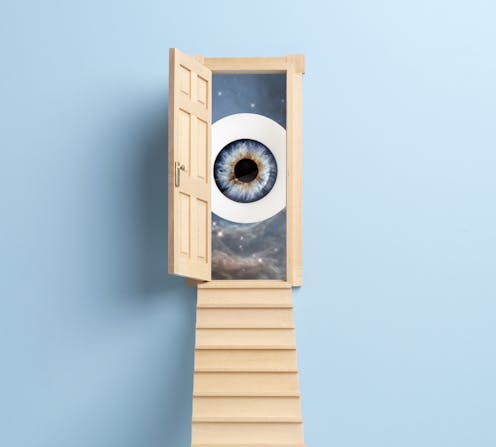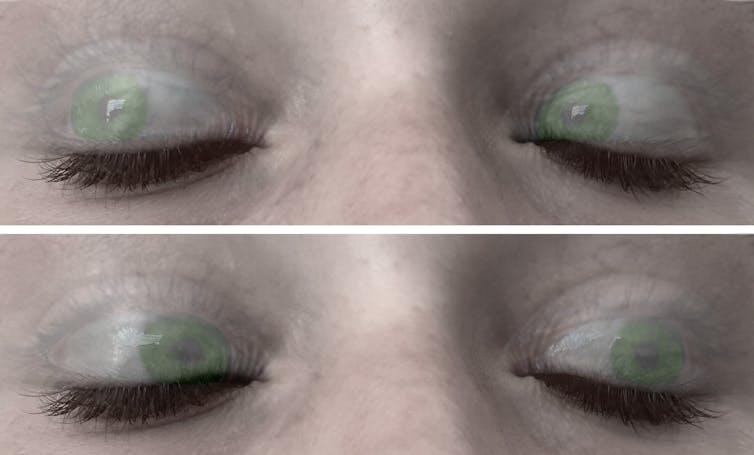Rapid eye movements in sleeping mice match where they are looking in their dreams, new research find
Why your eyes move during the REM stage of sleep has puzzled scientists for years. Researchers measured mice brains to look for a possible explanation.

Does rapid eye movement during sleep reveal where you’re looking at in the scenery of dreams, or are they simply the result of random jerks of our eye muscles? Since the discovery of REM sleep in the early 1950s, the significance of these rapid eye movements has intrigued and fascinated scores of scientists, psychologists and philosophers. REM sleep, as the name implies, is a period of sleep when your eyes move under your closed eyelids. It’s also the period when you experience vivid dreams.
We are researchers who study how the brain processes sensory information during wakefulness and sleep. In our recently published study, we found that the eye movements you make while you sleep may reflect where you’re looking in your dreams.
Measuring dreams
Past studies have attempted to address this question by monitoring the eye movements of people as they slept and waking them up to ask what they were dreaming. The goal was to find a possible connection between the content of a dream just before waking up (say, a car coming in from the left) and the direction the eyes moved at that moment.
Unfortunately, these studies have led to contradictory results. It could be that some participants inaccurately reported dreams, and it’s technically difficult to match a given eye movement to a specific moment in a self-reported dream.
We decided to bypass the problem of dream self-reporting. Instead, we used a more objective way to measure dreams: the electrical activity of a sleeping mouse brain.
Mice, like humans and many other animals, also experience REM sleep. Additionally, they have a sort of internal compass in their brains that gives them a sense of head direction. When the mouse is awake and running around, the electrical activity of this internal compass precisely reports its head direction, or “heading,” as it moves in its environment.
Interestingly, a previous study showed that this internal compass is active during REM sleep. But instead of reporting the actual, fixed head direction of the motionless sleeping mouse, the internal compass kept moving as if the mouse were awake, running around in the virtual environment of its dreams.
Eye movements and head movements are tightly coupled during wakefulness. This means that when people and mice shift their gaze, their heads and eyes turn in the same direction. We reasoned that if eye movements during REM sleep reveal gaze shifts in the world of dreams, those eye movements should occur at the same time and in the same direction as changes in heading in the sleeping mouse’s brain.

To test this hypothesis, we measured rapid eye movements, or saccades, when mice were awake and mapped this to the electrical activity of their brain’s internal compass. We then monitored the eye movements of sleeping mice during REM sleep with miniature cameras placed in front of both eyes. Because mice often do not completely close their eyelids while asleep, this allowed us to precisely measure the direction of their eye movements. As when the mice were awake, we recorded the electrical activity of their brain’s internal compass to decode changes in heading during REM sleep.
Strikingly, we discovered that eye movement direction in sleeping mice precisely matched changes in heading direction, very much like gaze shifts in mice that are awake. This meant that eye movements during REM sleep may disclose gaze shifts in the virtual world of dreams, providing a window into the cognitive processes occurring in the dreaming brain.
The dreaming brain
Our study shows that, during REM sleep, the part of the brain that controls the sense of head direction coordinates with the part that controls eye movements. This finding may just be the tip of the iceberg on how distinct parts of the brain function together as a whole during sleep.
If other brain areas also work together during REM sleep, like those responsible for sensory perception, emotion or sense of place, this overall coordination between parts may well be the basis for vivid and realistic dream experiences.
When you are awake, your sense of head direction relies on information gathered from several areas of the brain involved with your sense of balance and sight, among others, which are active when you move around. Our study brings up an important question: What does your sense of head direction rely on during REM sleep, when you aren’t moving?
Our next steps are to figure out what moves the brain’s internal compass during REM sleep, how it moves with the eyes and how different senses work together to generate the realistic experience of dreams.
Yuta Senzai has received funding from the Japan Society for the Promotion of Science.
Massimo Scanziani receives funding from the National Institute of Health and the Howard Hughes Medical Institute
Read These Next
As DOJ begins to release Epstein files, his many victims deserve more attention than the powerful me
Powerful men connected to Jeffrey Epstein are named, dissected and speculated about. The survivors,…
How to reduce gift-giving stress with your kids – a child psychologist’s tips for making magic and a
Depending on family circumstances and a child’s personality type, gift giving runs the gamut of fun…
Why are some Black conservatives drawn to Nick Fuentes?
Black Americans and white nationalists have joined forces in the past. And a number of cultural and…






